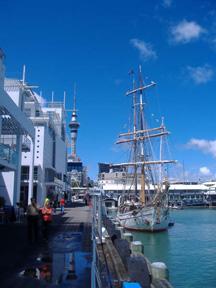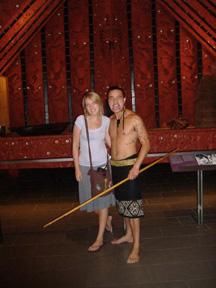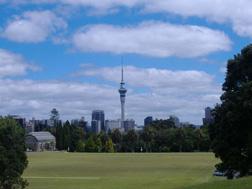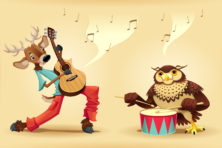The Life of a New Zealand Nanny
- Share
- Tweet
- Pin
- Share

Auckland Harbor.
The bus driver plays the Phantom of the Opera. Instead of studying my map, as I intended, on my five-minute trek over the Auckland Harbor Bridge, into the Auckland city centre, I smile as the overweight driver wearing black sunglasses whistles along to “The Music of the Night.” So, I am a typical tourist, standing at a street corner with map in hand.
Cruise ships, tall ships, yachts, charter boats, and sailboats line the harbor, where a string of ritzy restaurants open for lunch. I spot the New Zealand National Maritime Museum as the cruise ship blows its horn to the oohs and aahs of dozens of families pulling along their oversized luggage totes.
The exhibition begins with a digital movie: Te Waka: Our Great Journey. Polynesians sail to New Zealand, “guided only by the stars,” on large rafts. But the film is not without conflict or drama, oh no, the young boy aboard saves the entire boat by bravely climbing the mast during a storm, though his beloved pig drowns. It’s tough being an early settler.
I learn about New Zealand immigrants, boats, whalers, ferries, and lighthouses before wandering through Queen Street, complete with Prada, Gucci, and Versace, passing the Sky Tower bursting with tourists (I’ll save that for another day) and tourist shops selling greenstone necklaces, All Blacks rugby gear, and postcards.
Now, I am lost, in the hot sun and unfamiliar city. I cross a narrow bridge, wander through a residential area, a shopping center, past kebab shops, Asian takeaway bars, and a park featuring an intense cricket match, before spotting the building I starred in my New Zealand guidebook weeks ago – The New Zealand War Memorial Museum.
Housing an impressive collection of artifacts from around the world – a mummy, Edmund Hillary’s axe, and dinosaur bones – the museum also features a Maori Cultural Performance, displaying traditions of New Zealand’s native people. About the only thing I see in the entire building.

The Maori Cultural performers performing the Haka.
After viewing a collection of significant Maori artifacts – a long canoe, elaborate carvings of figures bearing seashells for eyes, protruding tongues for intimidation, and symmetrical tattoo engravings over the entirety of the face, the arms, and legs – I attend the performance. Three women and three men with Maori heritage chant, sing, dance, and perform the Haka, an intense (and loud) exercise meant to mentally prepare warriors for battle and intimidate the enemy, complete with thigh and chest slapping, bulging eyes and protruding tongue, in traditional dress.
I meet Richard after the performance, posing for the tourists, bulging his green eyes and flexing his tan tattooed muscles. I approach him before I even think of anything to say. You see, when you are traveling alone, you don’t often let the chance to interact with another person pass you by – even the ones who are paid to interact with you. So I ask him about the tattoo spanning his left shoulder, stretching to his neck and down his back, a common Maori custom in which the ink is engraved instead of injected. I ask him about his greenstone necklace, a family heirloom. I ask him questions that make me sound so naïve he assumes for a moment that I believe him and the other performers actually live in the Maori exhibition house at the museum.
He takes me through a ceremonial hall. He explains the purpose and meaning of the carved figures. He shows me Maori pantries. He asks me if I am free in a half an hour.
Hence – I see nothing else of the museum – I am too preoccupied with finding a bathroom and fixing my hair. I bet he is 28, an athletic history buff. He likes wine. He watches documentaries. He is willing to move to the US. He wants two children.

Richard, the Maori Warrior, and I, the classic tourist.
Older men drink tall glasses of beer at the sports bar, cheering and shouting at the TV displaying a horse race. Richard and I sit near the window, watching passer bys. He is 22. He is a university student who loves hip-hop. He wants to work in retail because he loves sneakers. He loves The Hills and Laguna Beach. He asks me about drive by shootings. He wants to know what the clubs are like in Las Vegas. “Never been.”
“Wisconsin?”
“Well – where I lived…we don’t really go to clubs, but the bars are fun.”
He takes a drink of beer while I fiddle with a silver ring in the shape of two joining vines.
“Do you own any bling?” he asks, exhaling after his drink.
“Uh – no.”
I think he was disappointed – the first American girl he has met and she likes folk music, owns no sneakers, and doesn’t know anyone from The Hills. She hasn’t even been a part of a drive by shooting.
He walks me to the bus station and we decide we probably won’t meet again. A hug, and I wave goodbye to Richard, the Maori warrior.
In celebration of an awkward afternoon, I buy myself a Cadbury Dairy Milk Bar and re-evaluate my tourist strategy for tomorrow – there are a few stars left encircled in my travel book…including the museum, for heavens sake, I hardly saw one floor. It’s tough being a tourist.
Sally Slattery was the Pulse’s Arts & Literature Intern during the summer and fall of 2008. After toiling away not only at the paper but also at Wilson’s during Door County’s busy season, she travelled to the islands of New Zealand for the winter where she gained valuable insight – not only about another side of the world but also about the other side of this thing we call tourism.


